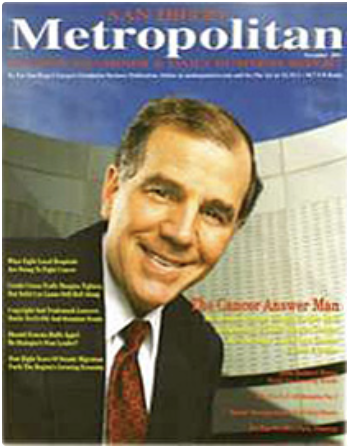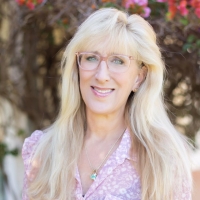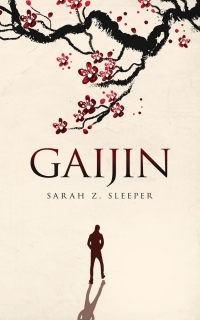UCSD’s Quiet New Cancer Czar
 In his late 70s, William Kronenberg began feeling lousy. Exhausted and aching, he figured he had overdone it during his move to California from New York. It was 1987 and not an auspicious start to his retirement in Laguna Hills with his wife, Dorothy. Consultations with physicians at UCLA resulted in bad news. Kronenberg wasn’t just tired. He had hairy cell leukemia, a serious, sometimes deadly, but slow-moving form of blood cancer, so-named because of the fuzzy “hair” that surrounds affected white blood cells.
In his late 70s, William Kronenberg began feeling lousy. Exhausted and aching, he figured he had overdone it during his move to California from New York. It was 1987 and not an auspicious start to his retirement in Laguna Hills with his wife, Dorothy. Consultations with physicians at UCLA resulted in bad news. Kronenberg wasn’t just tired. He had hairy cell leukemia, a serious, sometimes deadly, but slow-moving form of blood cancer, so-named because of the fuzzy “hair” that surrounds affected white blood cells.
Treated for three years with Interferon, a common anti-cancer drug, Kronenberg failed to improve. In 1990, when his oncologist suggested he try an experimental new treatment, he quickly regained his health. That therapy was called 2-chlorodeoxyadenosine, or 2-CdA.
At the time, 2-CdA hadn’t been approved by the Federal Drug Administration. Today, it is standard treatment for hairy cell leukemia, and it results in long-term remission in some 80 percent of patients, a scenario many people refer to as a cure.
The man who developed 2-CdA is Dr. Dennis Carson, who, as of Nov. 10, is the new director of the Rebecca and John Moores UCSD Cancer Center. “I feel very, very indebted to the scientist who developed (2-CdA). I owe my life to this guy,” Kronenberg says.
Today, Kronenberg is a lively, articulate 92-year-old who is grateful to Carson for the last 13 healthy years. Carson and Kronenberg have never met, and that’s typical. Thousands of people have gone into long-term remission using 2-CdA, marketed as Leustatin. But most probably don’t know of Carson.
Carson is an immunologist and biologist, a longtime professor of medicine, and director of the Sam and Rose Stein Institute for Research on Aging at UCSD. Like most medical researchers, he is largely unknown to the public at large. But unlike most, he is a member of an elite group of unique scientists who made groundbreaking discoveries and thereby healed many. And unlike most of that elite group, he also is a physician.
It is an unusual and lofty accomplishment for one person to take a medical discovery all the way from the laboratory to the bedside. That journey took 14 years and is an example of “translational medicine,” the concept of linking researchers and clinicians for the benefit of the patient. The idea is to bridge the gap between discovery, development, testing and practical application to speed the delivery of life-saving medications to sick people.
Carson synthesized 2-CdA in 1979, while he was an associate member of the Department of Basic and Clinical research at Scripps Clinic & Research Foundation. It took until 1993 to get FDA approval. In the intervening years, Carson drove the rigorous, all-consuming process of clinical trials. By its end he had left Scripps to join UCSD as adjunct professor and then director of the aging research institute. The project took more than a decade of Carson’s blood, sweat and tears.
“It was incredibly difficult in ways I can’t even explain,” Carson says. He understood that people’s lives were literally in his hands. “What if it all had failed?” he asks. “When the first dramatic responses in hairy cell leukemia were seen, I felt relief more than anything else.” Today, it’s increasingly rare for a scientist to follow his or her work all the way to the patient the way Carson did.
Carson is one of only a few people in the world who can rightly claim to have cured a cancer. While his efforts have garnered him worldwide acclaim, he’s modest about his accomplishments. “I wouldn’t call it a cure, but some patients are 20 years out,” Carson notes.
Others are more generous. “He’s one of the few people who has actually cured a cancer,” says Dr. Kenneth Kaushansky, chair of the UCSD Department of Medicine. “Twenty years without a disease is a cure in my book.”
As a true physician-scientist with expertise in several disciplines and experience taking treatments from the lab to the clinic, Carson is perfect for the post of director of the UCSD cancer center, says Kaushansky. Carson was selected from a field of about 70 candidates after a months-long, nationwide search. He is a creative innovator and an excellent communicator, says Kaushansky. Most importantly Carson is an evangelist for translational medicine. That’s exactly what officials at UCSD want — someone who can transform the cancer center into a translational medicine hub.
The Conundrum Of Carson
Although Carson has a long list of qualifications, you wouldn’t know it from his self-effacing, unassuming demeanor. Sitting in his tiny, cluttered office at SIRA, Carson looks every bit the stereotypical scientist. Friendly, soft-spoken in a slightly rumpled white shirt, he sits behind piles of papers spread across his small desk. A visitor must strain to catch each word.
“There’s a big problem in research in general in bringing together the clinicians at one end and the basic scientists at the other,” Carson says. “There are very few people who have the respect of both parties or a sufficient understanding of both parties.” By all accounts, Carson is one of those people.
“Dennis is a triple threat,” a teacher, scientist and clinician, says Dr. Edward Holmes, UCSD vice chancellor for Health Sciences and dean of the School of Medicine. He is an expert medical investigator, a well-known immunologist and cancer biologist and a proven leader, Holmes says. “He’s extraordinarily well-regarded by our faculty and nationally. He doesn’t say a lot, but what he says, you probably want to listen very carefully.”
Unlike some academics, Carson has a chunk of real-world experience. He founded four successful San Diego companies: Salmedix Inc., which sells cancer drugs; Vical Inc., a genetic vaccine maker; Triangle Pharmaceuticals Inc., a maker of AIDS drugs (sold to Gilead Inc. in 1995); and Dynavax Inc., an immunotherapy company. He still sits on the boards of Dynavax and Salmedix.
While some see any collaboration of academics with for-profit industry as less than ideal, Carson says his industry efforts in no way contradict his scientific work. “When investors want to put money in a company, they want to know that there’s an academic researcher devoting time and belief to it,” Carson says. “If I can get an investor to put money into an academically generated idea, I feel that’s an overall part of my mission.”
Still, Carson points out that universities and researchers should have no part in the marketing of drugs. He adheres to a strict policy of removing himself from the boards of companies before they go public, or at the time when products are in Phase 2 clinical trials. In the world of cancer care, Phase 1 trials test dosage levels and monitor side effects. Phase 2 trials examine a drug’s effectiveness. Phase 3 trials compare the results against side effects and other possible treatments.
The cost of testing new cancer treatments and bringing them to market can be defrayed if for-profit companies put their financial might behind them. That’s part of why Kaushansky and Holmes say quiet, diplomatic, experienced Carson is right for the role as UCSD’s translational medicine czar. Because he’s already done it, he knows how to skillfully straddle the sometimes at-odds roles of researcher, working alone to discover new therapies, and physician, striving to bring the best therapies to sick patients. And they say he can do it all while fostering relationships with industry that will benefit everybody interested in advancing cancer treatment.
If modest and unassuming are words that could rightly describe Carson, so are direct, driven and cutting-edge. Those who know him say Carson is much more than a quiet academic. Carson in May was inducted into the National Academy of Sciences, a rare distinction for a medical doctor, by a group whose membership is mostly scientists and engineers.
In addition to his multiple roles at UCSD and his four startups, Carson has deep ties to the San Diego community. He moved here from New York in 1970 to do his residency after completing his M.D. at Columbia University. Over the years, he has been affiliated with Scripps Clinic & Research Foundation and the Salk Institute, and spent time at the National Institutes of Health in Bethesda.
But Carson himself will be the last person to recite those accomplishments. All he wants to discuss during a 45-minute interview is his mission of making UCSD a nucleus of translational medicine. When asked about his personal accomplishments, he swings the conversation back to his vision for UCSD’s upcoming new cancer center building, a $100 million project set to be complete in early 2005.
Visions Of Collaboration
UCSD’s new building will put much of the university’s cancer research, diagnosis and treatment under one roof next to Thornton Hospital in La Jolla. At the moment, UCSD cancer center is geographically challenged with multiple sites. Bringing patients, doctors and researchers under one roof will foster translational medicine, officials say.
UCSD already is one of just 41 cancer centers in the U.S. designated by the National Cancer Institute as a Comprehensive Cancer Center. That means it achieved benchmarks for cancer research, patient care and community outreach. Carson plans to expand the scope and depth of cancer care. “By having the new building, we are going to create synergies between the scientists and the clinicians,” Kaushansky says.
Another component of Carson’s mission is active engagement of local business. UCSD cancer center researchers already have some $180 million in grants from the National Cancer Institute and others. And it has the brainpower of some of the world’s top molecular biologists. Under his watch, Carson says he hopes local business leaders will join UCSD in taking a big step toward the common goal of healing cancer patients by investing in promising therapies, even if they’re not blockbusters.
Carson says he’d love to see not only biotech and pharmaceutical companies, but also tech companies take a greater interest in fostering cancer research and treatment. As for tech company executives, Carson says, “If you can analyze a nuclear explosion, you should be able to help analyze whether a test is good for cancer.” At some point, he may designate a space in the new building for such work.
The spirit of collaboration is a fundamental part of Carson’s personal style. Carson aims to use collaboration as a tool “to develop a better diagnostic and prognostic paradigm for patients with cancer.” Such a modern, peer-to-peer approach is natural for Carson. His whole career, including the companies he founded, has been about bridging the gap between lab science and patient treatment.
As a teenager, Carson was a “science jock.” He attended Stuyvesant High School, a respected science academy in New York, where he took an interest in organic chemistry. “My parents told me to become a doctor and they were right,” he says. They pointed out that he could still be a chemist, but with the job security of a physician. During his post-doctoral work he specifically targeted areas like medicinal chemistry and pharmacology where doctors were less masterful. “The key to success is combining disparate knowledge in one individual,” he says.
Although some say that only a card-carrying oncologist should head up a cancer center, others say that a mix of skills goes furthest in translational medicine.
“I do know of Dr. Carson and truly admire his work,” says Dr. Francesco Marincola, editor of the Journal of Translational Medicine and director of the Immunogenetics Laboratory in the Department of Transfusion Medicine at the National Institutes of Health. “Very few can at the same time understand the significance of novel experimental findings and have the skill of designing corresponding clinical protocols. Basic science and clinical medicine live in parallel worlds of cognitive dissonance, the former performing experimentation that may not be of direct relevance to human disease and the other ignoring possible breakthroughs.” It’s a gap that has widened as regulatory restrictions and economic hurdles hamstring the medical communities’ efforts to bridge it, he adds.
Quietly Determined
Holmes and Kaushansky say Carson is the man to hurdle that gap. And Carson says San Diego is the right place. “With all the research centers and biotech companies and major pharma here, if we all come together, we are the ones to try to solve this,” Carson says. In the past, some have praised San Diego as an excellent research center, but not the place for top-notch cancer care. If the Rebecca and John Moores UCSD Cancer Center becomes a haven for translational medicine, that argument will be much harder to make.
Is anybody concerned that Carson’s exceptionally quiet demeanor could be a stumbling block? On the contrary, many call it an asset. “There are people who make loud noises and most of it is bluster and bluff,” Kaushansky says. “Dennis makes a statement and 99 times out of 100 it’s extremely well considered and probably the right answer.”
During his career, Carson has published 443 papers and been issued some 60 patents. Since 2-CdA, Carson has discovered and produced therapies for a number of cancer-producing gene mutations. The cyclin-dependent kinase 4 inhibitor, for example, is involved in brain cancer, leukemia, lung cancer and melanoma. Carson and UCSD’s Dr. Carlos Carrera developed a drug called Alanosine, now in clinical trials, that preferentially kills cancer cells with the defective gene.
Even his potential rivals give Carson kudos. “Dennis is modest, smart and hardworking,” says Dr. Alan Saven, director of Scripps Cancer Center. While Carson published scientific papers, Saven published clinical papers on 2-CdA. The two are friends who attend the same synagogue. Saven calls Carson’s development of 2-CdA “an example of very successful translational research.” Saven has treated at least 500 patients with it and says Scripps too is focused on translational medicine.
Saven wants to team with Carson on future projects. “I would hope now, with him being principally a scientist and myself being principally a clinician, that there will be synergies and collaborative efforts between our institutions,” Saven says.
In the long term, Carson hopes to see the creation of a comprehensive profile of different tumors, then the development of drugs that correspond to each. That’s many years away, but he is optimistic that it is possible.
As far as his immediate plans in his new role, Carson will try to get a handle on administrative issues and may expand the cancer center newsletter. He gets a salary boost, from $137,000 to $275,000, which won’t hurt. He and wife Sandra, an artist, sold their home not long ago and moved into an apartment.
The previous director, Dr. David Tarin, spent five years in the job. Carson will likely do the same. It’s not clear how much can be accomplished during that time. But any forward movement Carson and his colleagues at UCSD make toward better cancer treatment is something that could benefit San Diegans and others.
Even though his tenure at the cancer center is just starting, in the minds of some, Carson has done yeoman’s work for cancer patients already. “Thank God,” Kronenberg says, “for researchers like that.”

